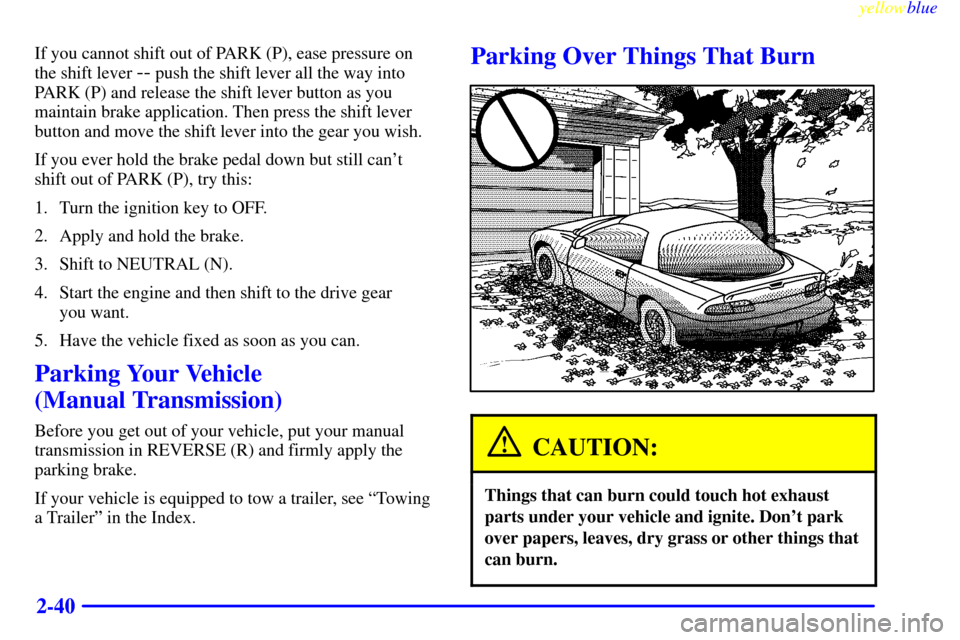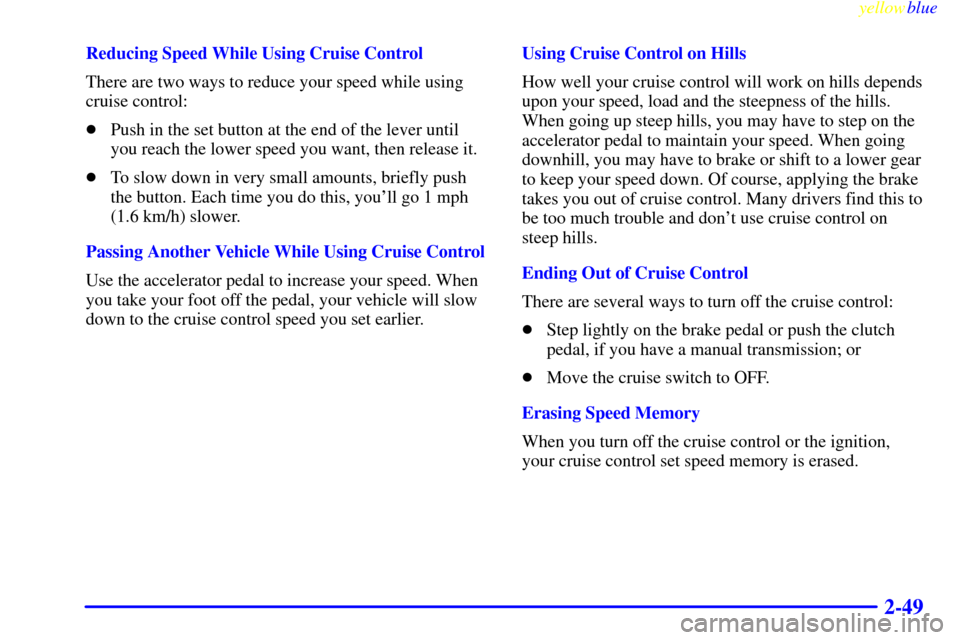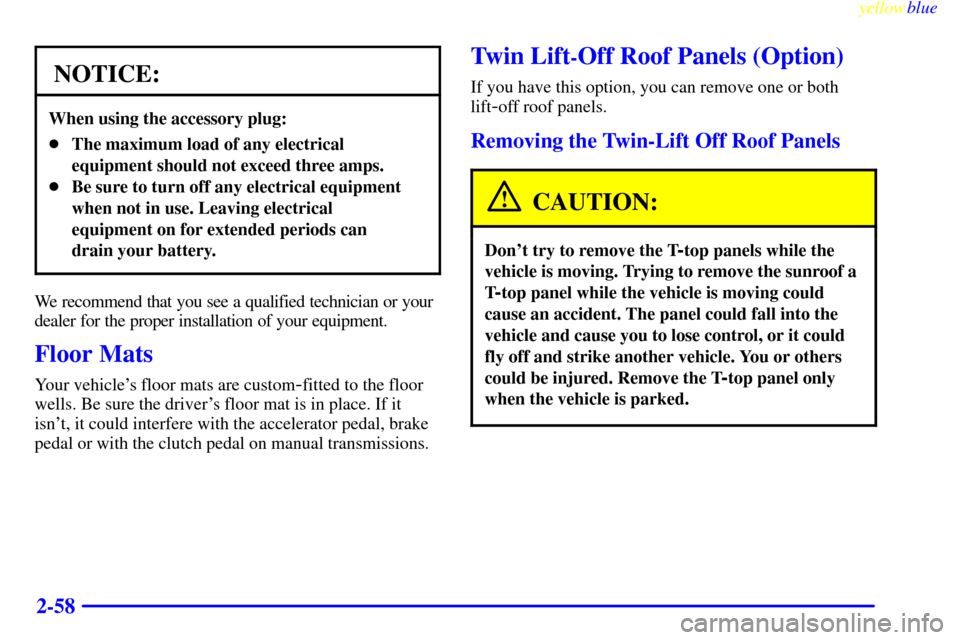Page 96 of 376

yellowblue
2-40
If you cannot shift out of PARK (P), ease pressure on
the shift lever
-- push the shift lever all the way into
PARK (P) and release the shift lever button as you
maintain brake application. Then press the shift lever
button and move the shift lever into the gear you wish.
If you ever hold the brake pedal down but still can't
shift out of PARK (P), try this:
1. Turn the ignition key to OFF.
2. Apply and hold the brake.
3. Shift to NEUTRAL (N).
4. Start the engine and then shift to the drive gear
you want.
5. Have the vehicle fixed as soon as you can.
Parking Your Vehicle
(Manual Transmission)
Before you get out of your vehicle, put your manual
transmission in REVERSE (R) and firmly apply the
parking brake.
If your vehicle is equipped to tow a trailer, see ªTowing
a Trailerº in the Index.
Parking Over Things That Burn
CAUTION:
Things that can burn could touch hot exhaust
parts under your vehicle and ignite. Don't park
over papers, leaves, dry grass or other things that
can burn.
Page 103 of 376

yellowblue
2-47 Cruise Control (Option)
With cruise control, you can
maintain a speed of about
25 mph (40 km/h) or more
without keeping your foot
on the accelerator.
This can really help on long trips. Cruise control does
not work at speeds below about 25 mph (40 km/h).
When you apply your brakes or push the clutch pedal
(manual transmission) the cruise control shuts off.CAUTION:
�Cruise control can be dangerous where you
can't drive safely at a steady speed. So,
don't use your cruise control on winding
roads or in heavy traffic.
�Cruise control can be dangerous on
slippery roads. On such roads, fast changes
in tire traction can cause needless wheel
spinning, and you could lose control. Don't
use cruise control on slippery roads.
If your vehicle is in cruise control when the optional
Acceleration Slip Regulation System (ASR) begins to
limit wheel spin, the cruise control will automatically
disengage. (See ªASR Systemº in the Index.) When
road conditions allow you to safely use it again, you
may turn the cruise control back on.
Page 105 of 376

yellowblue
2-49
Reducing Speed While Using Cruise Control
There are two ways to reduce your speed while using
cruise control:
�Push in the set button at the end of the lever until
you reach the lower speed you want, then release it.
�To slow down in very small amounts, briefly push
the button. Each time you do this, you'll go 1 mph
(1.6 km/h) slower.
Passing Another Vehicle While Using Cruise Control
Use the accelerator pedal to increase your speed. When
you take your foot off the pedal, your vehicle will slow
down to the cruise control speed you set earlier.Using Cruise Control on Hills
How well your cruise control will work on hills depends
upon your speed, load and the steepness of the hills.
When going up steep hills, you may have to step on the
accelerator pedal to maintain your speed. When going
downhill, you may have to brake or shift to a lower gear
to keep your speed down. Of course, applying the brake
takes you out of cruise control. Many drivers find this to
be too much trouble and don't use cruise control on
steep hills.
Ending Out of Cruise Control
There are several ways to turn off the cruise control:
�Step lightly on the brake pedal or push the clutch
pedal, if you have a manual transmission; or
�Move the cruise switch to OFF.
Erasing Speed Memory
When you turn off the cruise control or the ignition,
your cruise control set speed memory is erased.
Page 112 of 376
yellowblue
2-56
Removing the Cargo Cover
1. Close the cover. If the cargo cover is not closed and
resting on the trim panel, it cannot be removed.
2. Pull the cover toward you to unsnap it. Then slide
the cargo cover along the groove in the trim panel.
Reverse the steps to install the cover.When carrying large or heavy items, it is a good idea to
open the cover and place the items in the rear area.
CAUTION:
An improperly stored cargo cover could be
thrown about the vehicle during a collision or
sudden maneuver. You or others could be
injured. If you remove the cover, always store it
outside your vehicle. When you put it back,
always be sure that it is securely reattached.
Ashtray and Cigarette Lighter
Lift up the cover to open the ashtray. To remove it, lift
up on the right side of the ashtray. If you have an
automatic transmission, the ashtray is near the front of
your console. If you have a manual transmission, the
ashtray is near your cupholder.
Page 114 of 376

yellowblue
2-58
NOTICE:
When using the accessory plug:
�The maximum load of any electrical
equipment should not exceed three amps.
�Be sure to turn off any electrical equipment
when not in use. Leaving electrical
equipment on for extended periods can
drain your battery.
We recommend that you see a qualified technician or your
dealer for the proper installation of your equipment.
Floor Mats
Your vehicle's floor mats are custom-fitted to the floor
wells. Be sure the driver's floor mat is in place. If it
isn't, it could interfere with the accelerator pedal, brake
pedal or with the clutch pedal on manual transmissions.
Twin Lift-Off Roof Panels (Option)
If you have this option, you can remove one or both
lift
-off roof panels.
Removing the Twin-Lift Off Roof Panels
CAUTION:
Don't try to remove the T-top panels while the
vehicle is moving. Trying to remove the sunroof a
T
-top panel while the vehicle is moving could
cause an accident. The panel could fall into the
vehicle and cause you to lose control, or it could
fly off and strike another vehicle. You or others
could be injured. Remove the T
-top panel only
when the vehicle is parked.
Page 121 of 376
yellowblue
2-65
You can store the sunshades two different ways:
�When the T
-tops are in use, store the sunshades in
their storage area in the rear of the vehicle, and make
sure the cargo cover is in its closed, upright position.
�When you have the T
-tops off and in their storage
slots, store the sunshades on the T
-tops, in their
installed position.
Convertible Top (If Equipped)
The following procedures explain the proper operation
of your convertible top.
Lowering Your Convertible Top
NOTICE:
Don't leave your convertible out with the top
down for any long periods of time. The sun and
the rain can damage your seat material and other
things inside your vehicle.
1. It is recommended that you park on a level surface.
Set the parking brake firmly. Shift an automatic
transmission into PARK (P) or a manual
transmission into REVERSE (R). The ignition must
be in ACC or RUN. Lower both sun visors.
Page 126 of 376
yellowblue
2-70 Raising Your Convertible Top
1. It is recommended that you park on a level surface.
Set the parking brake firmly. If you have an
automatic transmission, shift into PARK (P). If you
have a manual transmission, shift into
REVERSE (R). The ignition must be in ACC, RUN
or RAP must be on. Then lower both sun visors and
lower both windows at least three inches (8 cm). If
the boot cover is in place, it must be removed first.
NOTICE:
It is not recommended that you raise or lower the
top while the vehicle is moving.
2. Push and hold the up
arrow (
�) on the
convertible TOP switch.
3. Pull down on the latches and align the hooks with
the holes. Push forward on the larger part of the latch
until it clicks. Do not force the latch. If it is hard to
lock, the top is not properly aligned.
Page 214 of 376

yellowblue
4-38
When you're turning with a trailer, make wider turns than
normal. Do this so your trailer won't strike soft shoulders,
curbs, road signs, trees or other objects. Avoid jerky or
sudden maneuvers. Signal well in advance.
Turn Signals When Towing a Trailer
When you tow a trailer, your vehicle may need a
different turn signal flasher and/or extra wiring. Check
with your dealer. The arrows on your instrument panel
will flash whenever you signal a turn or lane change.
Properly hooked up, the trailer lamps will also flash,
telling other drivers you're about to turn, change lanes
or stop.
When towing a trailer, the arrows on your instrument
panel will flash for turns even if the bulbs on the trailer
are burned out. Thus, you may think drivers behind you
are seeing your signal when they are not. It's important
to check occasionally to be sure the trailer bulbs are
still working.
Driving On Grades
Reduce speed and shift to a lower gear before you start
down a long or steep downgrade. If you don't shift
down, you might have to use your brakes so much that
they would get hot and no longer work well.On a long uphill grade, shift down and reduce your
speed to around 45 mph (70 km/h) to reduce the
possibility of engine and transmission overheating.
If you are towing a trailer and you have an automatic
transmission with overdrive, you may prefer to drive in
DRIVE (D) instead of AUTOMATIC OVERDRIVE (�)
(or, as you need to, a lower gear). Or, if you have a
manual transmission with FIFTH (5) or SIXTH (6) gear.
It is better not to use FIFTH (5) or SIXTH (6) gear. Just
drive in FOURTH (4) gear (FIFTH (5) gear if you have
a six
-speed manual transmission--or, as you need to, a
lower gear).
Parking on Hills
CAUTION:
You really should not park your vehicle, with a
trailer attached, on a hill. If something goes
wrong, your rig could start to move. People can
be injured, and both your vehicle and the trailer
can be damaged.